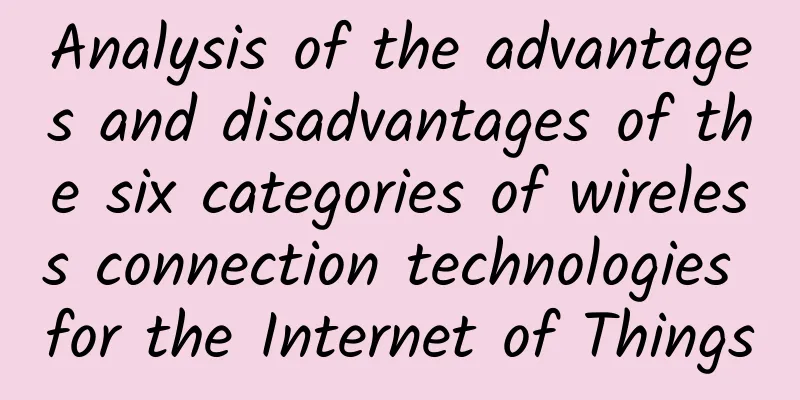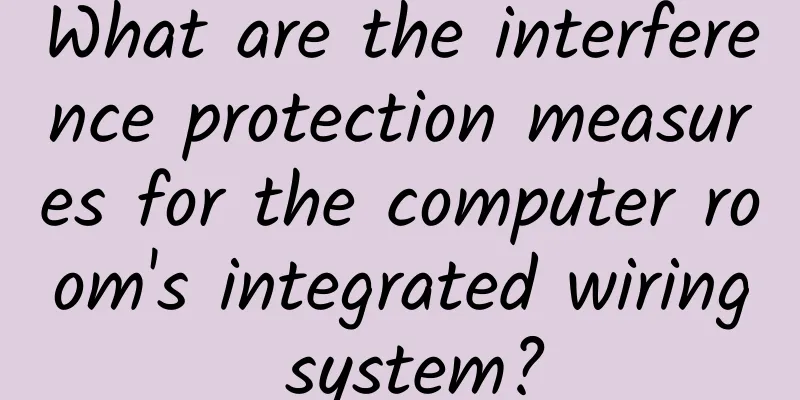Analysis of the advantages and disadvantages of the six categories of wireless connection technologies for the Internet of Things

|
IoT applications have penetrated into our lives, and IoT projects can be found in all aspects. So, what are the IoT wireless connection technologies? This article takes 6 types of wireless technologies as examples to deeply analyze the advantages and disadvantages of each type.
1. Ethernet Ethernet is a local area network communication technology. The IEEE 802.3 standard of the IEEE organization has formulated the technical standards for Ethernet, which stipulates the content including the connection of the physical layer, electronic signals and the media access layer protocol. Ethernet uses twisted pair as the transmission medium and can cover a range of up to 200 meters without relays. The most popular type of Ethernet has a data transmission rate of 100Mb/s, and the newer standard supports rates of 1KMb/s and 10KMb/s. The biggest advantage of Ethernet technology is that it is the most commonly used LAN technology, and has gradually replaced other LAN standards such as Token Ring, FDDI and ARCNET. The Internet we are familiar with now refers to the global network formed by connecting all these large and small LANs together. 2. Serial communication technology Serial port is a very common interface for communication between devices, and is also widely used for communication between devices and instruments. Common serial ports include RS-232 (using 25-pin or 9-pin connectors) and half-duplex RS-485 and full-duplex RS-422 for industrial computer applications. Serial communication uses serial communication, that is, the serial port sends and receives byte sequences bit by bit. Typically, the serial port is used to transmit ASCII characters. Serial communication is completed using 3 wires: ground, send and receive. Serial communication can use the transmit line to send data and the receive line to receive data at the same time. It is simple and can achieve long-distance communication, and its communication length can reach 1200 meters. (1) Advantages The biggest advantage of serial communication is its high popularity. Serial ports are still standard on PCs. Usually, most industrial equipment has serial ports for the convenience of connecting printers. For those devices without serial ports, the common method during their development is to connect them to the development computer through serial ports. Therefore, serial ports are the simplest and easiest way for devices to communicate. It is also worth mentioning that the cost of serial communication is very low if you don't consider the cables connecting the serial ports. (2) Disadvantages Serial communication has poor networking capabilities. Although it is usually more stable than wireless, it is also susceptible to electromagnetic influences from the cable environment in industrial environments, resulting in unstable communication and even serial port burnout. The communication speed of the serial port is still far behind that of Ethernet. Generally speaking, it is only suitable for low-speed and small-data-volume communications. 3. Modbus Unlike the previous communication technologies, Modbus is generally considered to be only an application layer protocol standard that uses serial communication, and it does not include electrical specifications. Modbus was originally published by Modicon in 1979 for communication with programmable logic controllers (PLCs), and later derived into three modes: Modbus RTU, Modbus ASCII, and Modbus TCP. The physical interface used by the first two is the serial port introduced above, and the latter uses the Ethernet interface. With the widespread application of PLC in the industrial field, Modbus has also become the most popular communication protocol in the industrial field. It adopts master/slave communication, that is, one-to-many connection. One master controller can support up to 247 slave controllers. (1) Advantages The main advantages of Modbus are:
(2) Disadvantages Modbus has the following main problems:
4. GPRS GPRS is the abbreviation of General Packet Radio Service*, which is a long-distance communication technology between terminals and communication base stations. Radio services first used analog communication technology, known as the first generation of mobile communication technology, and later used digital communication technology, known as the second generation of mobile communication technology. Among them, the Global System for Mobile Communications (GSM) is the most widely used and successful. GSM is mainly designed for voice transmission, and voice occupies a dedicated channel when transmitting. GPRS can be said to be the continuation of GSM. It transmits data in packets and does not monopolize channels, so it can make better use of idle channel resources on GSM. The transmission rate of GPRS can reach 56~114Kbps. Using this data service, users can connect to the communication base station of the telecom operator, and then connect to the Internet to obtain Internet information. GPRS was launched by the European Telecommunications Standards Institute (ETSI) and later handed over to the 3rd Generation Partnership Project (3GPP). (1) Advantages
(2) Disadvantages
5. NFC NFC, Near-field communication, is often translated into Chinese as near-field communication. NFC is a short-range high-frequency radio technology, a type of RFID technology, with an operating frequency of 13.56MHz and an effective working distance of less than 20cm. Its transmission speed is 106Kb/s, 212Kb/s or 424Kb/s. Data is read and exchanged through three business modes: card, card reader and point-to-point.
NFC was first developed by Philips Semiconductors, Nokia and Sony in 2002. In 2004, the NFC Forum was established to standardize and promote near-field communication technology. (1) Advantages
NFC communication technology is currently widely used in mobile payments and consumer electronics. For example, many mobile phones already support NFC applications, and small payment systems such as bus cards all use NFC technology. (2) Disadvantages
6. LoRa LoRa comes from the word Long Range, which is a communication technology for long-distance communication. LoRa technology is based on linear Chirp spread spectrum modulation, which continues the low power consumption characteristics of frequency shift keying modulation, but greatly increases the communication range. Chirp spread spectrum modulation has long-distance transmission and good anti-interference performance, and has been used in military and aerospace communications for many years. In extreme cases, a single LoRa gateway or base station can cover an entire city or dozens of kilometers. Typical application scenarios of LoRa technology include: ultra-long battery life (several years), long-distance communication between nodes, and low data rates (such as only a few data transfers per hour). Like NB-IoT technology, low power consumption indicators can also be sacrificed to increase the rate. |
Recommend
Wireless communication technologies within reach in daily life - WiFi, Bluetooth and NFC
WiFi Wi-Fi (Wireless Fidelity) is a wireless LAN ...
DNSPOD Thursday Carnival, .COM 20 yuan/first year
DNSPOD launched a Thursday Carnival Special Offer...
The world's IPv4 addresses are officially exhausted!
The long-feared exhaustion of global IPv4 address...
10gbiz 40% off on all VPS hosts, Hong Kong CN2 GIA/Los Angeles CN2 GIA lines available
10gbiz's promotion is still going on, with 40...
Aruba Launches ArubaESP, the Industry’s First Cloud-Native Platform for the Intelligent Edge
Aruba, a Hewlett Packard Enterprise company, today...
Recommended DNS public servers
114 Public DNS Universal high-speed version: DNS ...
Wu Hequan analyzes the misunderstandings of 5G application in industrial Internet: a new 5G2B architecture needs to be developed
At the summit forum of the "Fifth Future Net...
As 5G technology matures, can it help accelerate the implementation of blockchain?
2019 has become the hot spot for the development ...
5G and the Internet of Things empower the home appliance industry to promote the consumption of green and energy-saving home appliances
The great progress of social productivity has giv...
How long will it take for 5G to be fully commercialized? Why?
Recently, a netizen asked, how long will it take ...
ZJI: Hong Kong Kwai Wan cluster server is online, bandwidth upgraded to 2C segment 120 IP monthly payment from 1120 yuan/month
ZJI has newly launched the Hong Kong Kwai Wan Dat...
How does Spanning Tree Protocol prevent network loops and ensure security?
Spanning Tree Protocol (STP) is one of the key me...
Four major trends in China's Internet development
On April 20, 1994, China gained full access to th...
Focusing on intelligent network connectivity and IoT innovation, H3C made a stunning appearance at the 2019 World Internet of Things Expo
[51CTO.com original article] On September 7, the ...
What will the communications network look like in 2030?
[[426987]] This article is reprinted from the WeC...









